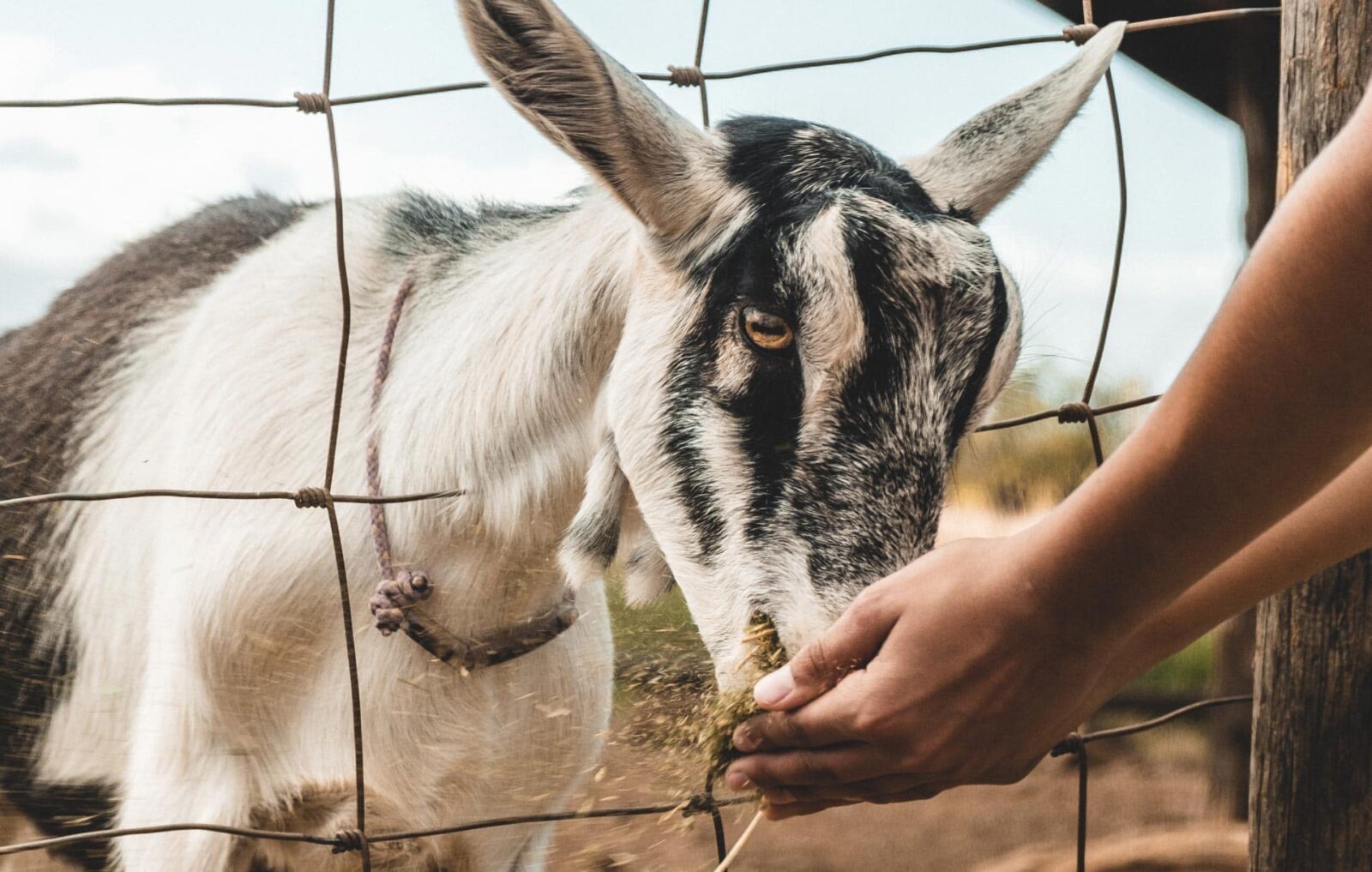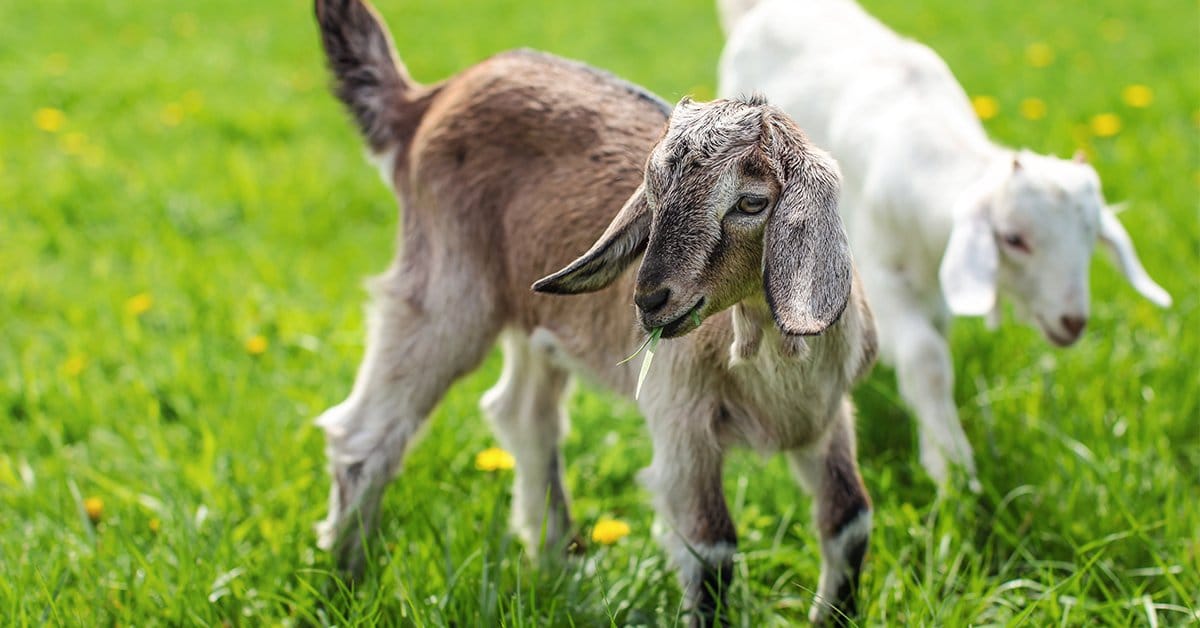Are you finding it difficult to feed goats on your farm? Well, you can easily manage the feeding process with a goat feeder.
In this guide, you will learn about the benefits of using a goat feeder, and why it’s widely used in farms.
Before discussing the specifics of a goat feeder, it’s important to understand why it’s beneficial to have one. Installing a functional and durable feeder can help reduce overall feed costs and improve the health of your animals, by providing them access to a nutritious and balanced diet.
Goats are natural foragers, so having a goat feeder connected to their adjusting foraging needs is essential. A goat feeder allows them access to controlled amounts of nutrients which improves their overall health as well as helps cut back on wasted food and messy encounters indoors. Goats are also more exposed to parasites when they eat ground-level food, making a raised goat feeder an ideal way to protect their health while eating.
In addition, using a proper goat feeder will make sure the goats get fed on regular intervals without having to prompt you all day. It also eliminates overcrowding around the trough and ensures uniform milk production throughout the herd, improved fertility rates in goats, increased milk production with better milk quality, overall greater longevity of your goats and healthier body condition scores at checkup time.
Definition of a goat feeder
A goat feeder is a specially designed container or trough used to store and deliver food or hay to goats. Goat feeders can be constructed from a variety of materials and designs, and can range in size, shape, and cost.
The most common types are wooden or plastic containers with lid openings sized to accommodate the head of a goat and enable access by only one animal at a time. The containers are usually fitted with steel tread plates on the bottom or sides that enable multiple animals to feed concurrently in order to discourage bullying within herds or flocks.
Feeders may also feature removable partitions to facilitate adjustable portions for individual animals, as well as drainage holes for clean-out purposes.

Importance of using a goat feeder on a farm
A goat feeder is an essential item for any farm that keeps goats. It allows the farm owner to easily control and manage the feed given to their animals while helping reduce waste, mess and money spent. It can also help the animal to better digest its food by introducing a safe and balanced diet.
Goats require a different type of diet than other animal species, so it is important that their feeder be specifically designed for them. Feeders designed for cane and other livestock will not meet their needs as they are more easily clipped by their horns, tampered with or knocked over, leading to excessive wastage of feed.
Using a goat feeder also has multiple benefits when compared to simply laying out hay in sleeping areas or limited grazing on a pasture or field. By using the feeder, goats can have up to twice as much space in which they can freely roam without fear of stepping on their own food or having too much hay directly next to them which can cause hoof rot and bloat. Additionally, using a specialised goat feeder encourages activity in the animals, keeps them busy and even helps prevent boredom due to lack of access to food at one central point,. This improves mental well-being which has long term health implications for the goats living on your farm.
Goat feeders also save time for both you as the farmer and for your animals as they always know where their food will be! This makes feeding easier as all animals can be fed in one go instead of taking multiple trips around your paddocks or fields while ensuring that any fresh fodder remains clean until it gets eaten quickly by your hungry livestock!
Purpose of the guide
This guide is intended to help farmers maximize their use of goat feeders and understand the numerous benefits they can provide. By discussing the characteristics of goat feeders and the many advantages they possess, this guide aims to equip farms with the information needed to make an informed decision on whether or not to incorporate them into their operations.
In addition, this guide also covers how goat feeders can be used correctly and safely in order to ensure optimum feeding efficiency for goats. With all that in mind, let’s explore what a goat feeder is and why farmers would benefit from having one.
Advantages of Using a Goat Feeder
Goat feeders create a system of control over the amount, type, and frequency that each goat is fed. By using portion control for goats, you can ensure that feed does not go to waste with one goat eating all the food before another gets its share. Feeders can also reduce feed waste from goats pooping or pawing in their feed. Not to mention, it helps to keep pests away from the feeding area, as well as reduces mess from hay and other loose feeds.
Goat feeders also provide a hygienic environment for feeding as they keep your goats food off the ground. Additionally, this elevated means of feeding encourages height in goats which gives them better posture and helps them develop strong muscles which leads to a better quality of life overall. The even distribution of meals also reduces competition among your herd and prevents bullying or aggression towards smaller goats that may not get their fair share during mealtimes if they’re competing with larger animals in a free choice setting.
Finally, goat feeders can help save time as you no longer have to manually fill each bucket throughout the day with individual portions of grain or hay; this allows you to set up automated cycles so that everyone’s meals are timed perfectly while still giving them full access to food!
Improved feed efficiency
Using a goat feeder can lead to improved feed efficiency on your farm. This is because the feeders help reduce the amount of grain that is wasted as it falls on the ground, as well as reduce the amount of time spent on cleaning and refilling troughs.
With an automatic feeder, you’ll have peace of mind knowing that each day your goats will receive just enough to meet their dietary requirements while also reducing feed waste. By controlling how much food they are given, you’ll be able to monitor both their consumption and health more closely with more accurate records. This in turn will enable you to adjust their diets according to their needs.
Additionally, with a quality automatic goat feeder, chaffing issues caused by other feeding methods may be reduced or eliminated all together. The consistent location for feeding provides easy access for all animals without any crowding around the trough, leading to less stress overall at mealtime. Less stress when eating means smoother digestion, improved nutrient absorption from their food and happier animals overall!
Better feed management
Using a goat feeder can help keep your animals’ food secure while also keeping the feed organized and preventing it from becoming contaminated. This improved feed management helps reduce the risk of disease, maintain nutrition levels and keep feed costs down.
When it comes to feeding goats, many farmers struggle with efficient and safe storage. A goat feeder, on the other hand, is ideal for managing hay or pellets in a way that allows goats to access their food while preventing waste. Some benefits of using this type of feeding system include:
- Reduced wasting of hay or pellets – By providing an easily accessible area to store food, you will save money by not having to purchase more feeds as frequently due to their reduction in wastage.
- Better containment and control – Goats are notoriously picky eaters, and using a goat feeder eliminates much of the mess associated with traditional hay or pellet bags or troughs.
- Prevention of disease transmission – There is a risk that unsanitary conditions can lead to diseases such as gastrointestinal worms being transmitted between animals when they share a common eating area. Goat feeders come with built in protective components that block the spread of germs from one animal to another.
- Saves time – Feeding your herd becomes easier than ever when using a goat feeder because no longer must you fill each individual trough before every meal; rather all you have to do is refill each container and let your goats enjoy their meals!
Reduced feed waste
One of the most significant benefits of using a goat feeder is that it can help to reduce the amount of feed waste. With a secure goat feeder, you can ensure that the feed is properly and evenly distributed for your animals. This will prevent them from taking too much at once, thus reducing the amount of food or feed that could be wasted from over-consumption.
Feed wastage can also be reduced when using a goat feeder as many models are designed to keep larger animals such as horses and dogs out, thereby reducing how much food is eaten by animals other than your goats.

Factors to Consider When Choosing a Goat Feeder
When making the decision to get a goat feeder, there are a few important factors you should take into consideration. There are many types of feeders to choose from and they vary in design, cost and size. Before making your purchase, think about the type of area you have available and the number of goats on your farm that you plan to feed. Here are some factors to consider when choosing a goat feeder.
- The Size: Goat feeders come in a variety of sizes so make sure you measure your available space before deciding on the size that will work for you. You also need to consider how many goats you would like to use it for. If you have more than one goat, getting a larger model might be wise as it can save time and make feeding easier in the long run.
- Cost: Feeders vary greatly in cost depending on the type of materials used and features they offer. Consider both quality and affordability when choosing a model that’s right for your farm as well as any other associated costs such as installation or assembly fees that might be required for certain models.
- Durability & Maintenance: High-quality brands with strong construction can last much longer than cheaper alternatives which may need replacing more frequently due to wear or corrosion from harsh weather conditions outdoors. Spend some extra time researching different models before investing in one so that you can ensure durability and minimal maintenance needs over time.
- Design Factors: From high-sided walled troughs to circular troughs for easy access, modern designed goat feeders come with several design options ranging from traditional style troughs to more advanced designs with lids or vertical feed sections to keep out rodents or pests. Make sure whichever model fits your farm is easy to clean and make sure its design won’t put any stress on their back while they eat!
Size
When considering a goat feeder, the size you choose is important. The size of a goat depends largely on its age and breed, but most adult goats will require at least a 4 gallons-capacity feeder.
If you intend to keep multiple breeds and ages in one pen, you should opt for larger feeders so all your goats can eat simultaneously. A too-small feeder won’t be able to accommodate all your goats at once, resulting in aggression and injury among members of the herd.
To ensure that your goats can access their food comfortably and safely, ensure that the feeder is at least 2 feet wide and deep enough that your tallest animal can eat without having to ask another to move or back away from the trough.
Material
When selecting a goat feeder, there are several important factors to consider. Most goat feeders are made of metal, plastic or wood and can come in a variety of sizes to meet your needs. Here’s an overview of the advantages and disadvantages of each material:
Metal Feeders: Stainless steel is the most popular choice for goat feeders because it’s strong and corrosion-resistant so it won’t rust. The metal will also last longer than plastic or wood, making it a more cost-effective option for long-term use.
Plastic Feeders: Plastic goat feeders are often made from recycled materials, providing an eco-friendly option for those concerned about the environment. Plastic feeders are lightweight and weather-resistant, but these materials may not last as long as metal versions over time.
Wood Feeders: Wood is both durable and easy to clean, making it one of the preferred choices for indoor barns or small backyards where space is limited. Wood also provides a natural material that is visually appealing and will last several years without warping or cracking with normal use.
Ease of use
Goat feeders are designed to be a convenient and efficient way for farmers to feed their animals. Whether you’re using buckets, troughs, or hay nets, goat feeders provide a hassle-free way to get the food into the stomachs of your herd. With an adjustable lids and self-locking hinges, they are easy to use, secure, and keep pests away from the food.
The hopper style of goat feeder features a raised lid that can swing down into feeding position. This lid system allows feeding without having to constantly lift heavy buckets or barrels with your hands every time you need to refill the feeder. The adjustable lids also ensure that goats have adequate access to their food while keeping uninvited guests out of your herd’s mealtime. The locking hinge keeps the lid securely in place even when goats stand on it trying to reach their food.
Another major benefit of using a goat feeder is that it creates an efficient space for your goats where you can control how much food is available in each container. If there’s too much competition for resources among animals within a herd this can lead to stress, so by controlling the amount of food available in each container and thus regulating how long it takes for everyone to eat, this eliminates stress associated with competing for resources among anywhere from 1 or 2 up to hundreds of goats.
Overall, goat feeders are an invaluable tool for farmers looking for ways to simplify their operation and create a controlled environment where all goats can receive adequate nutrition without stressing out other members in the herd.
Durability
Goat feeders are designed to withstand the environmental conditions on a farm. Feeders are usually made from plastic, which is rust-proof and weather-resistant. It is important to check the durability of a feeder before purchasing it as some feeders may not be robust enough for prolonged outdoor use.
Look for feeders with reinforced edges, extra strength plastic components or additional supports that provide enhanced stability. A durable goat feeder can guarantee that food will be held securely in place, making sure your goats have access to fresh and nutritious hay or grain when they need it most.

Conclusion
After reading this guide, you should have a good understanding of the benefits of using a goat feeder on your farm. It is clear that there are both economic and time-saving advantages to investing in a good quality feeder.
Feeding goats is an integral part of animal husbandry and with today’s advancements in technology, proper feeding practices are easier than ever before. If you are looking to improve your methods of feeding goats, then you may want to consider investing in a quality goat feeder. Properly nourishing your animals is essential for their well-being and overall health.
The information provided here should help guide you as you begin the process of selecting the most appropriate feeder for your operation.
FAQ
What are the benefits of goat farm?
The benefits of goat farming include a source of milk, meat, and fiber, natural weed control, and a potential source of income.
Do goats need feeders?
Yes, goats need feeders to ensure they have access to the appropriate amount of feed and to prevent waste.
What is a feeder goat?
A feeder goat is a young goat that is raised specifically for meat production and is typically sold for slaughter.
What are the adv3antages of stall fed goat farming?
The advantages of stall fed goat farming include efficient use of resources, improved herd health and management, and higher production of milk and meat.
Why is feeding goats important?
Feeding goats is important for their health, growth, and productivity. It provides them with essential nutrients and energy to support their body functions and production.
What are the best practices in goat farming?
The best practices in goat farming include proper feeding and nutrition, adequate shelter and space, good hygiene, disease prevention and control, and responsible breeding practices.
How much is a feeder goat?
The price of a feeder goat depends on the breed, age, weight, and market demand, but typically ranges from $100 to $400 per animal.
What is the best way to feed goats?
The best way to feed goats is to provide them with a balanced diet that includes hay or pasture, grains, and minerals, and to ensure they have access to clean water at all times.
What is the price of goat feeder in India?
The price of a goat feeder in India varies depending on the type and size of the feeder, but typically ranges from 500 to 3000 INR.
What are the different types of goat feeders?
The different types of goat feeders include trough feeders, hay feeders, creep feeders, automatic feeders, and free-choice feeders.
See Also :
- Best cattle waterer 2023
- Best tractor paint 2023
- Best chicken coop 2023
- Best wood chipper for small farm 2023
- Best chicken coops for 6 chickens 2023


